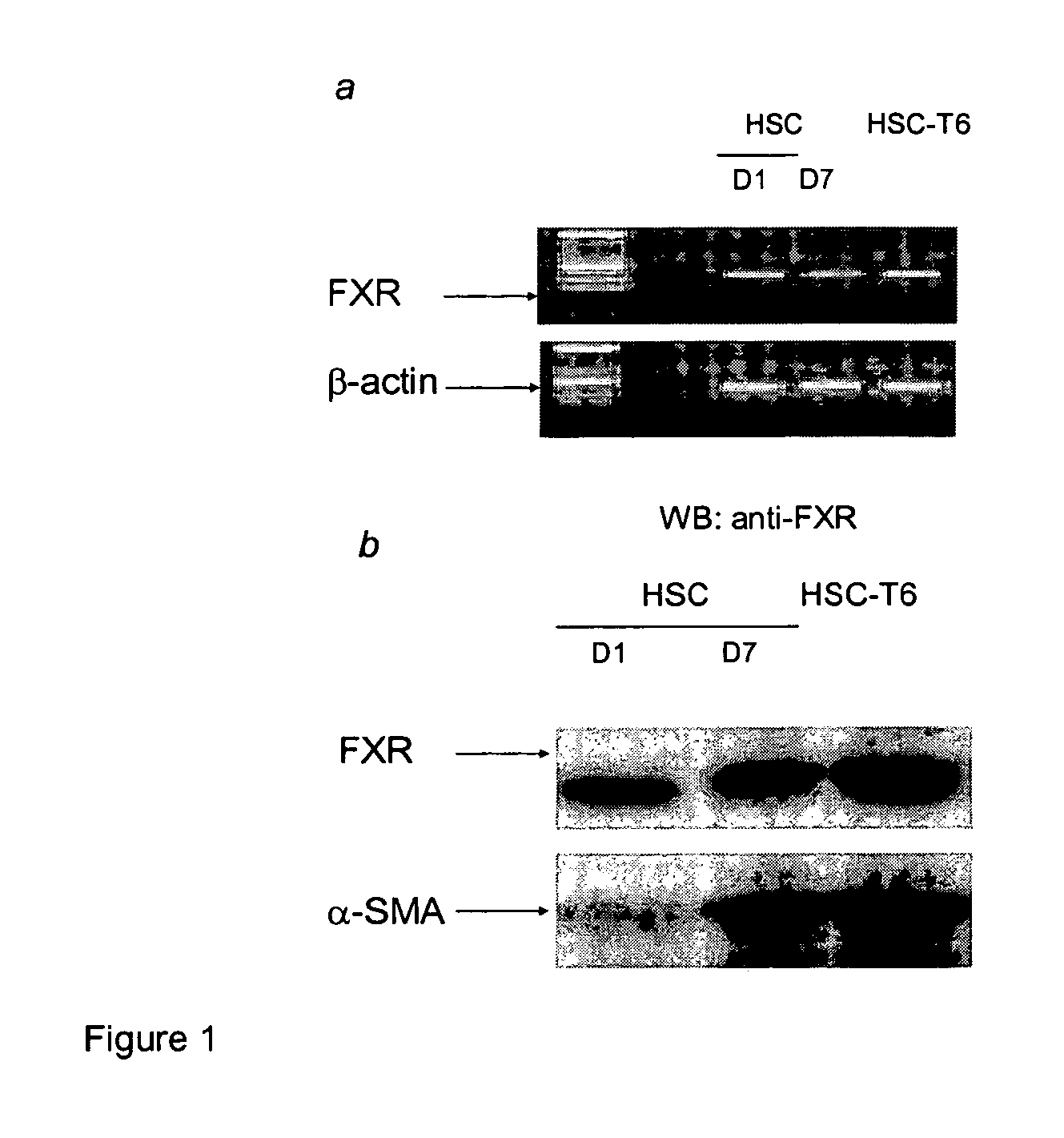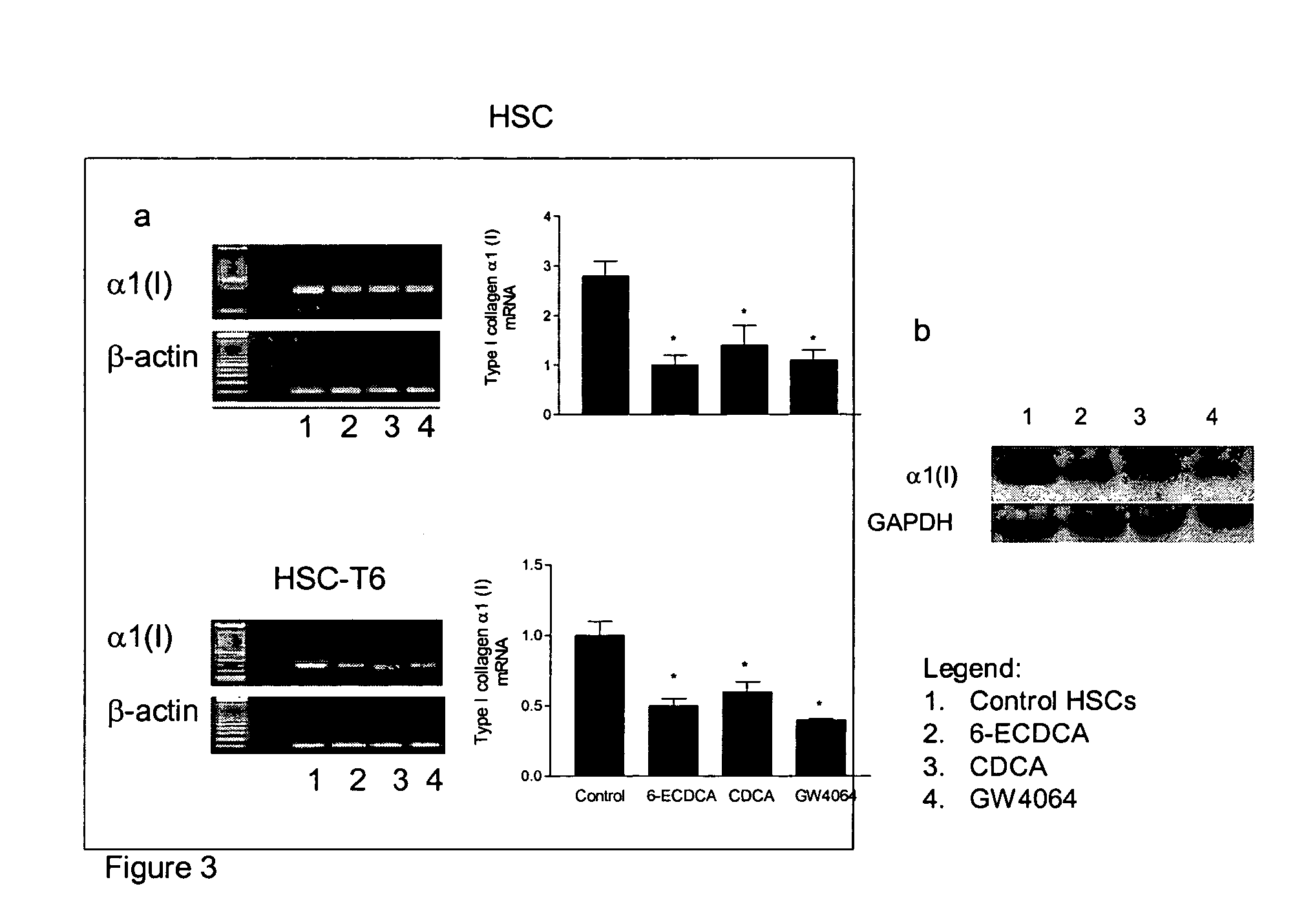Treatment of fibrosis using FXR ligands
a technology of fibrosis and ligands, applied in the direction of drug compositions, extracellular fluid disorders, metabolic disorders, etc., can solve the problems of tissue fibrosis, normal function of affected tissue, and no effective treatment currently available, and achieve the effect of inhibiting fibrosis
- Summary
- Abstract
- Description
- Claims
- Application Information
AI Technical Summary
Benefits of technology
Problems solved by technology
Method used
Image
Examples
example 1
FXR Ligand-Mediated Suppression of Collagen Type α1 Expression in Hepatic Stellate Cells (HSC)
[0277]Liver fibrosis leading eventually to cirrhosis is a scarring process of the liver that includes components of both increased fibrogenesis and wound contraction. Hepatic stellate cells (HSCs) are recognized as the main cell type responsible for liver fibrogenesis. In chronic liver disease, HSCs acquire an “activated” phenotype, which includes increased proliferation, contractility, fibrogenesis, matrix degradation, chemotaxis, and cytokine release (Friedman, J. Biol. Chem. 275:2247-2250, 2000). The current paradigm postulates that the activated state of HSCs is achieved through the transformed microenvironment, which is supported in part by the growth factors Platelet-Derived Growth Factor (PDGF) and Transforming Growth Factor (TGF)-β, reactive oxygen intermediates released by hepatocytes and by the fibrillar matrix generated by previously activated HSCs, as well as in response to stim...
example 2
Administration of FXR Ligands Results in Reduced Fibrosis in Bile Duct Ligated (BDL) Rats
[0293]BDL is a model of chronic cholestasis. In this model, however, progressive liver fibrosis leads to the development of cirrhosis 3-4 weeks after ligation and it is therefore also used as a model of liver fibrosis (Kountouras et al., Br. J. Exp. Pathol., 65:305-311, 1984). Because this model allows us to test the effect of anti-fibrotic remedies, we administered rats 3 days after BDL with 6ECDCA at the dose of 1 and 3 mg / kg per os per day for 2 weeks. The protocol's study was approved by the Animal Study Committee of the University of Perugia. Hepatic fibrosis was induced in 8-9 weeks old male Wistar rats (Charles River, Monza, Italy) by BDL. BDL was performed as originally described by Kountouras et al. (Br. J. Exp. Pathol. 65: 305-311; 1984). One week after BDL, rats were randomized to receive one of the following treatments, placebo (subcutaneous injection of 100 μL PBS) or 6ECDCA at the ...
example 3
Administration of FXR Ligands to Inhibit Fibrosis
[0296]The present invention can be practiced according to the following example. A 58-year old female patient, weighing about 60 kg, suffers from chronic Hepatitis C Virus (HCV) infection and is seeking treatment to inhibit development and progression of liver fibrosis. The patient's blood serum levels of alkaline phosphatase, GGT, and 5′ nucleotidase are considered to fall within a range that is not indicative of a cholestatic condition. After assessment of liver fibrosis status and staging by performing liver biopsy and / or measurement of non-invasive serum markers, tablets containing 6ECDCA are prescribed to the patient for oral administration on a twice-per-day schedule. A total of 300 mg 6ECDCA is taken each day. The patient is on this schedule for the remainder of her life. The development or progression of liver fibrosis can be monitored based on measuring serum markers or analyzing liver biopsy.
[0297]All patents, patent applica...
PUM
 Login to View More
Login to View More Abstract
Description
Claims
Application Information
 Login to View More
Login to View More - R&D
- Intellectual Property
- Life Sciences
- Materials
- Tech Scout
- Unparalleled Data Quality
- Higher Quality Content
- 60% Fewer Hallucinations
Browse by: Latest US Patents, China's latest patents, Technical Efficacy Thesaurus, Application Domain, Technology Topic, Popular Technical Reports.
© 2025 PatSnap. All rights reserved.Legal|Privacy policy|Modern Slavery Act Transparency Statement|Sitemap|About US| Contact US: help@patsnap.com



